Australian Dairy Industry: Challenges, Opportunities, and Growth
VerifiedAdded on 2020/03/04
|8
|1317
|126
Report
AI Summary
This report provides an in-depth analysis of the Australian dairy industry, exploring its significant contribution to the national economy and its position as a major global exporter. It identifies key challenges faced by the industry, including the short lifespan of dairy cows due to intensive farming practices, environmental concerns related to greenhouse gas emissions, and the impact of seasonal farming and global market competition from countries like Europe and New Zealand. The report also highlights growth opportunities, such as increasing global demand for dairy products, especially in developing countries, and the potential to capitalize on rising incomes and changing dietary habits in Asia. It emphasizes the importance of targeting high-value segments and leveraging trade agreements like the China-Australia Free Trade Agreement to expand exports. The report concludes by noting investments in the industry and the need for strategic policies to maintain a competitive advantage and address ethical and environmental concerns.
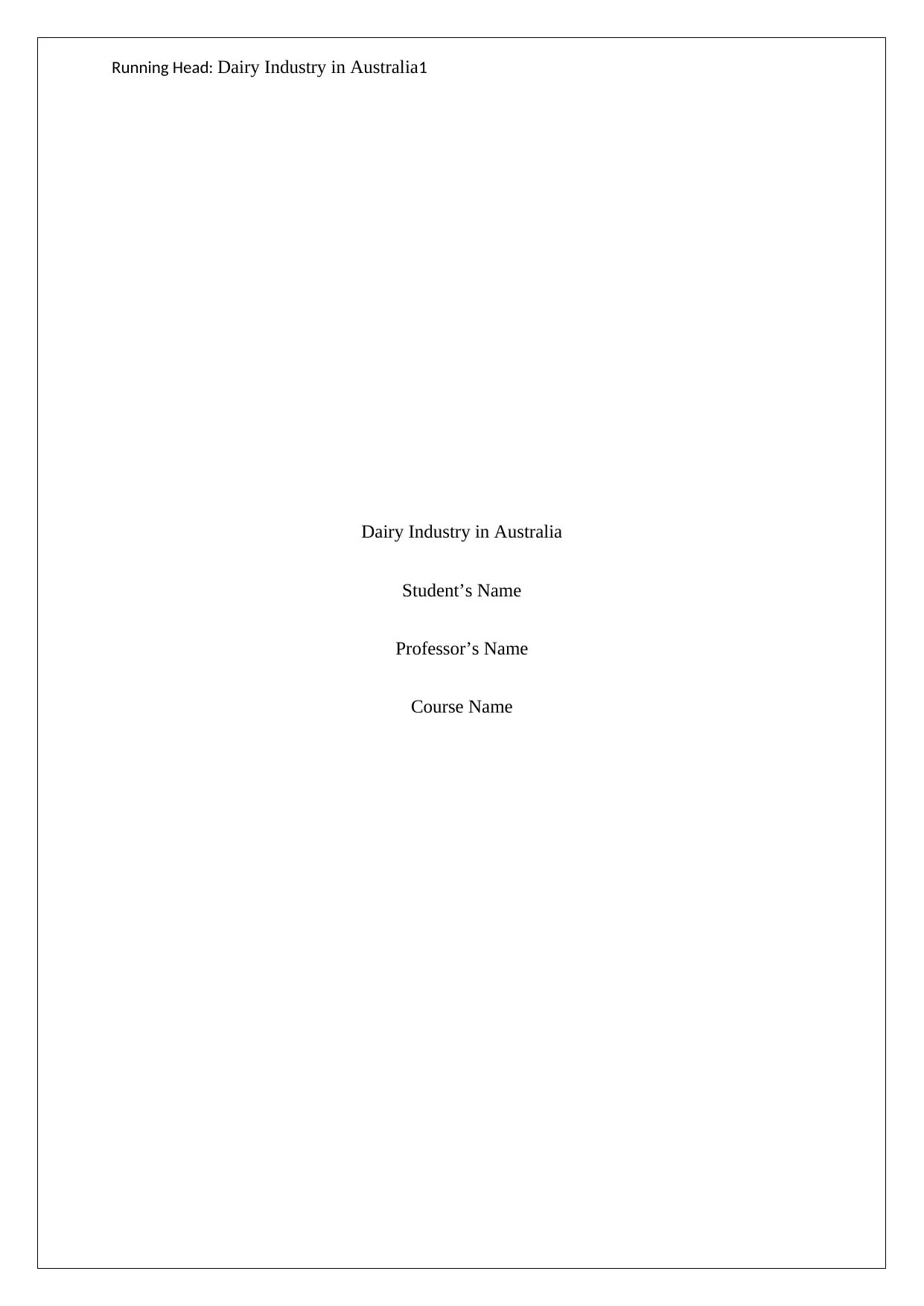
Running Head: Dairy Industry in Australia1
Dairy Industry in Australia
Student’s Name
Professor’s Name
Course Name
Dairy Industry in Australia
Student’s Name
Professor’s Name
Course Name
Paraphrase This Document
Need a fresh take? Get an instant paraphrase of this document with our AI Paraphraser
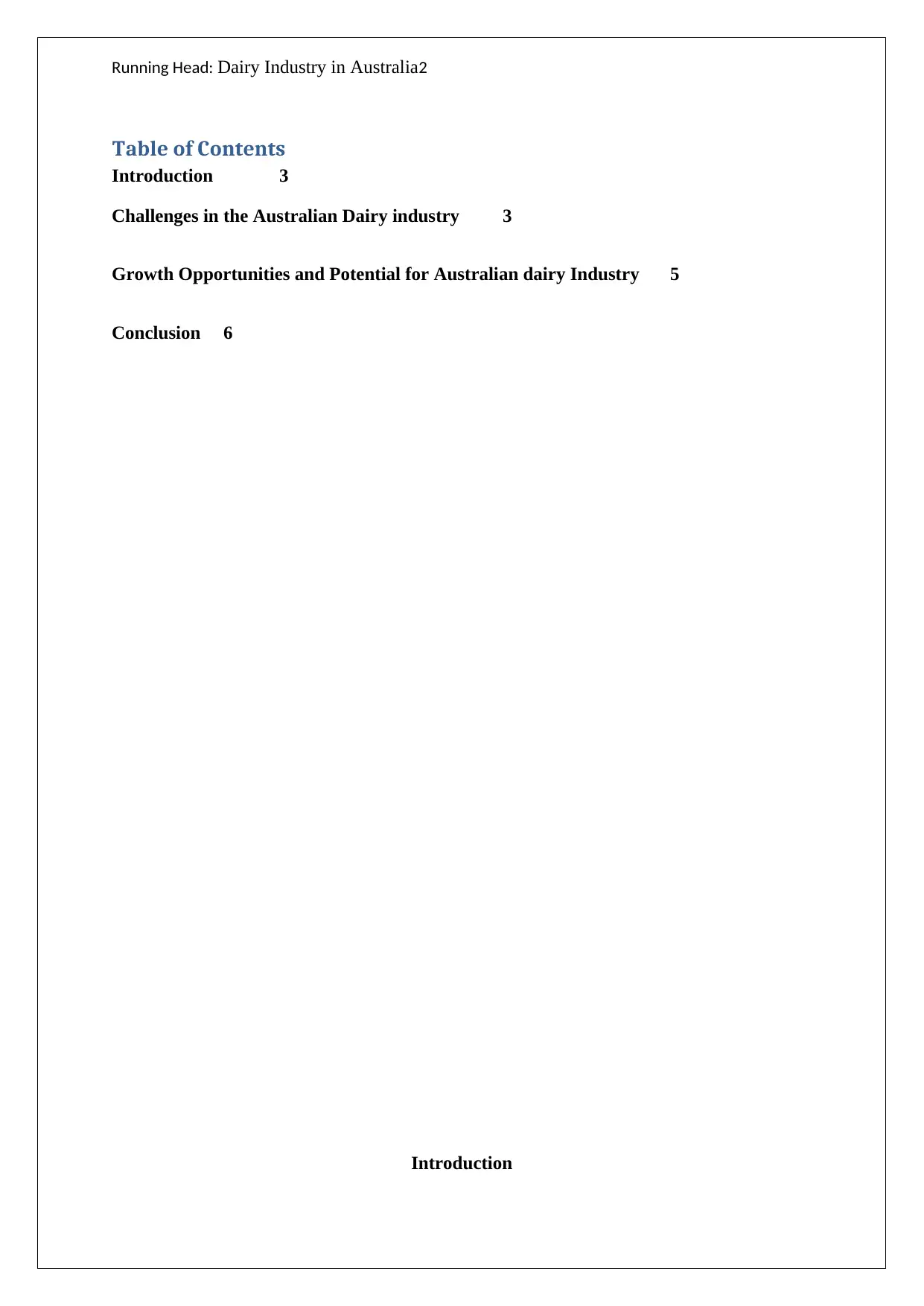
Running Head: Dairy Industry in Australia2
Table of Contents
Introduction 3
Challenges in the Australian Dairy industry 3
Growth Opportunities and Potential for Australian dairy Industry 5
Conclusion 6
Introduction
Table of Contents
Introduction 3
Challenges in the Australian Dairy industry 3
Growth Opportunities and Potential for Australian dairy Industry 5
Conclusion 6
Introduction
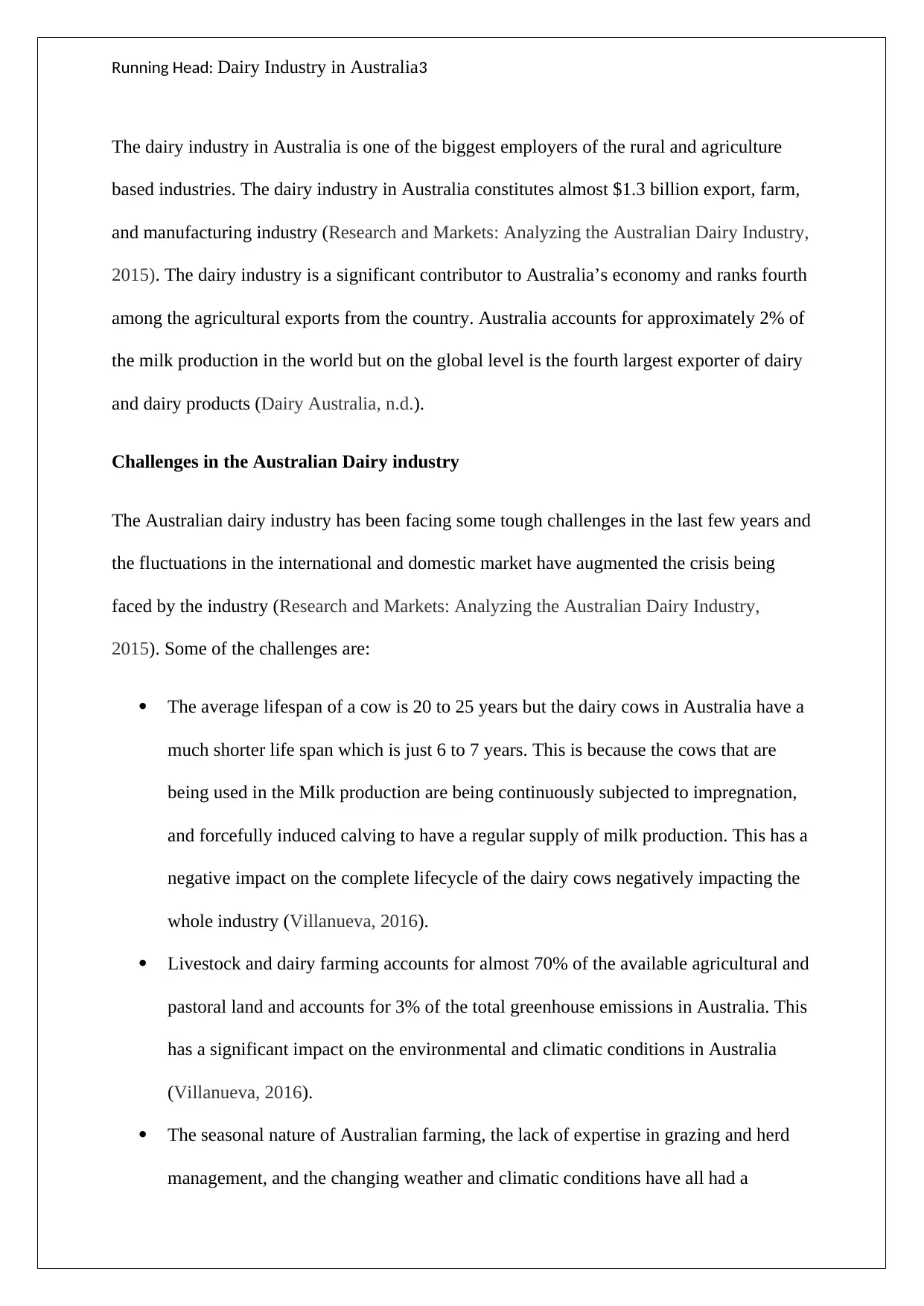
Running Head: Dairy Industry in Australia3
The dairy industry in Australia is one of the biggest employers of the rural and agriculture
based industries. The dairy industry in Australia constitutes almost $1.3 billion export, farm,
and manufacturing industry (Research and Markets: Analyzing the Australian Dairy Industry,
2015). The dairy industry is a significant contributor to Australia’s economy and ranks fourth
among the agricultural exports from the country. Australia accounts for approximately 2% of
the milk production in the world but on the global level is the fourth largest exporter of dairy
and dairy products (Dairy Australia, n.d.).
Challenges in the Australian Dairy industry
The Australian dairy industry has been facing some tough challenges in the last few years and
the fluctuations in the international and domestic market have augmented the crisis being
faced by the industry (Research and Markets: Analyzing the Australian Dairy Industry,
2015). Some of the challenges are:
The average lifespan of a cow is 20 to 25 years but the dairy cows in Australia have a
much shorter life span which is just 6 to 7 years. This is because the cows that are
being used in the Milk production are being continuously subjected to impregnation,
and forcefully induced calving to have a regular supply of milk production. This has a
negative impact on the complete lifecycle of the dairy cows negatively impacting the
whole industry (Villanueva, 2016).
Livestock and dairy farming accounts for almost 70% of the available agricultural and
pastoral land and accounts for 3% of the total greenhouse emissions in Australia. This
has a significant impact on the environmental and climatic conditions in Australia
(Villanueva, 2016).
The seasonal nature of Australian farming, the lack of expertise in grazing and herd
management, and the changing weather and climatic conditions have all had a
The dairy industry in Australia is one of the biggest employers of the rural and agriculture
based industries. The dairy industry in Australia constitutes almost $1.3 billion export, farm,
and manufacturing industry (Research and Markets: Analyzing the Australian Dairy Industry,
2015). The dairy industry is a significant contributor to Australia’s economy and ranks fourth
among the agricultural exports from the country. Australia accounts for approximately 2% of
the milk production in the world but on the global level is the fourth largest exporter of dairy
and dairy products (Dairy Australia, n.d.).
Challenges in the Australian Dairy industry
The Australian dairy industry has been facing some tough challenges in the last few years and
the fluctuations in the international and domestic market have augmented the crisis being
faced by the industry (Research and Markets: Analyzing the Australian Dairy Industry,
2015). Some of the challenges are:
The average lifespan of a cow is 20 to 25 years but the dairy cows in Australia have a
much shorter life span which is just 6 to 7 years. This is because the cows that are
being used in the Milk production are being continuously subjected to impregnation,
and forcefully induced calving to have a regular supply of milk production. This has a
negative impact on the complete lifecycle of the dairy cows negatively impacting the
whole industry (Villanueva, 2016).
Livestock and dairy farming accounts for almost 70% of the available agricultural and
pastoral land and accounts for 3% of the total greenhouse emissions in Australia. This
has a significant impact on the environmental and climatic conditions in Australia
(Villanueva, 2016).
The seasonal nature of Australian farming, the lack of expertise in grazing and herd
management, and the changing weather and climatic conditions have all had a
⊘ This is a preview!⊘
Do you want full access?
Subscribe today to unlock all pages.

Trusted by 1+ million students worldwide
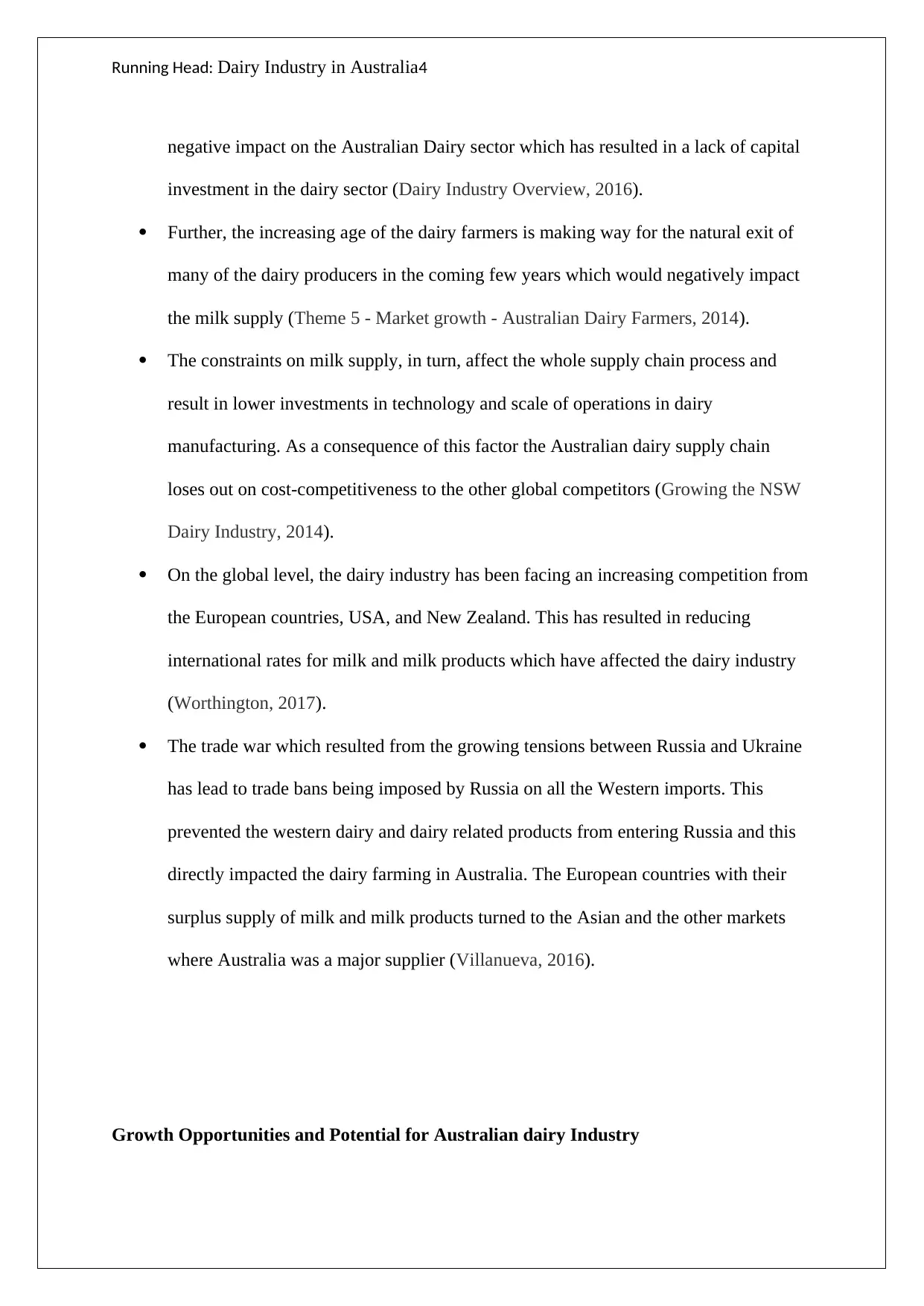
Running Head: Dairy Industry in Australia4
negative impact on the Australian Dairy sector which has resulted in a lack of capital
investment in the dairy sector (Dairy Industry Overview, 2016).
Further, the increasing age of the dairy farmers is making way for the natural exit of
many of the dairy producers in the coming few years which would negatively impact
the milk supply (Theme 5 - Market growth - Australian Dairy Farmers, 2014).
The constraints on milk supply, in turn, affect the whole supply chain process and
result in lower investments in technology and scale of operations in dairy
manufacturing. As a consequence of this factor the Australian dairy supply chain
loses out on cost-competitiveness to the other global competitors (Growing the NSW
Dairy Industry, 2014).
On the global level, the dairy industry has been facing an increasing competition from
the European countries, USA, and New Zealand. This has resulted in reducing
international rates for milk and milk products which have affected the dairy industry
(Worthington, 2017).
The trade war which resulted from the growing tensions between Russia and Ukraine
has lead to trade bans being imposed by Russia on all the Western imports. This
prevented the western dairy and dairy related products from entering Russia and this
directly impacted the dairy farming in Australia. The European countries with their
surplus supply of milk and milk products turned to the Asian and the other markets
where Australia was a major supplier (Villanueva, 2016).
Growth Opportunities and Potential for Australian dairy Industry
negative impact on the Australian Dairy sector which has resulted in a lack of capital
investment in the dairy sector (Dairy Industry Overview, 2016).
Further, the increasing age of the dairy farmers is making way for the natural exit of
many of the dairy producers in the coming few years which would negatively impact
the milk supply (Theme 5 - Market growth - Australian Dairy Farmers, 2014).
The constraints on milk supply, in turn, affect the whole supply chain process and
result in lower investments in technology and scale of operations in dairy
manufacturing. As a consequence of this factor the Australian dairy supply chain
loses out on cost-competitiveness to the other global competitors (Growing the NSW
Dairy Industry, 2014).
On the global level, the dairy industry has been facing an increasing competition from
the European countries, USA, and New Zealand. This has resulted in reducing
international rates for milk and milk products which have affected the dairy industry
(Worthington, 2017).
The trade war which resulted from the growing tensions between Russia and Ukraine
has lead to trade bans being imposed by Russia on all the Western imports. This
prevented the western dairy and dairy related products from entering Russia and this
directly impacted the dairy farming in Australia. The European countries with their
surplus supply of milk and milk products turned to the Asian and the other markets
where Australia was a major supplier (Villanueva, 2016).
Growth Opportunities and Potential for Australian dairy Industry
Paraphrase This Document
Need a fresh take? Get an instant paraphrase of this document with our AI Paraphraser
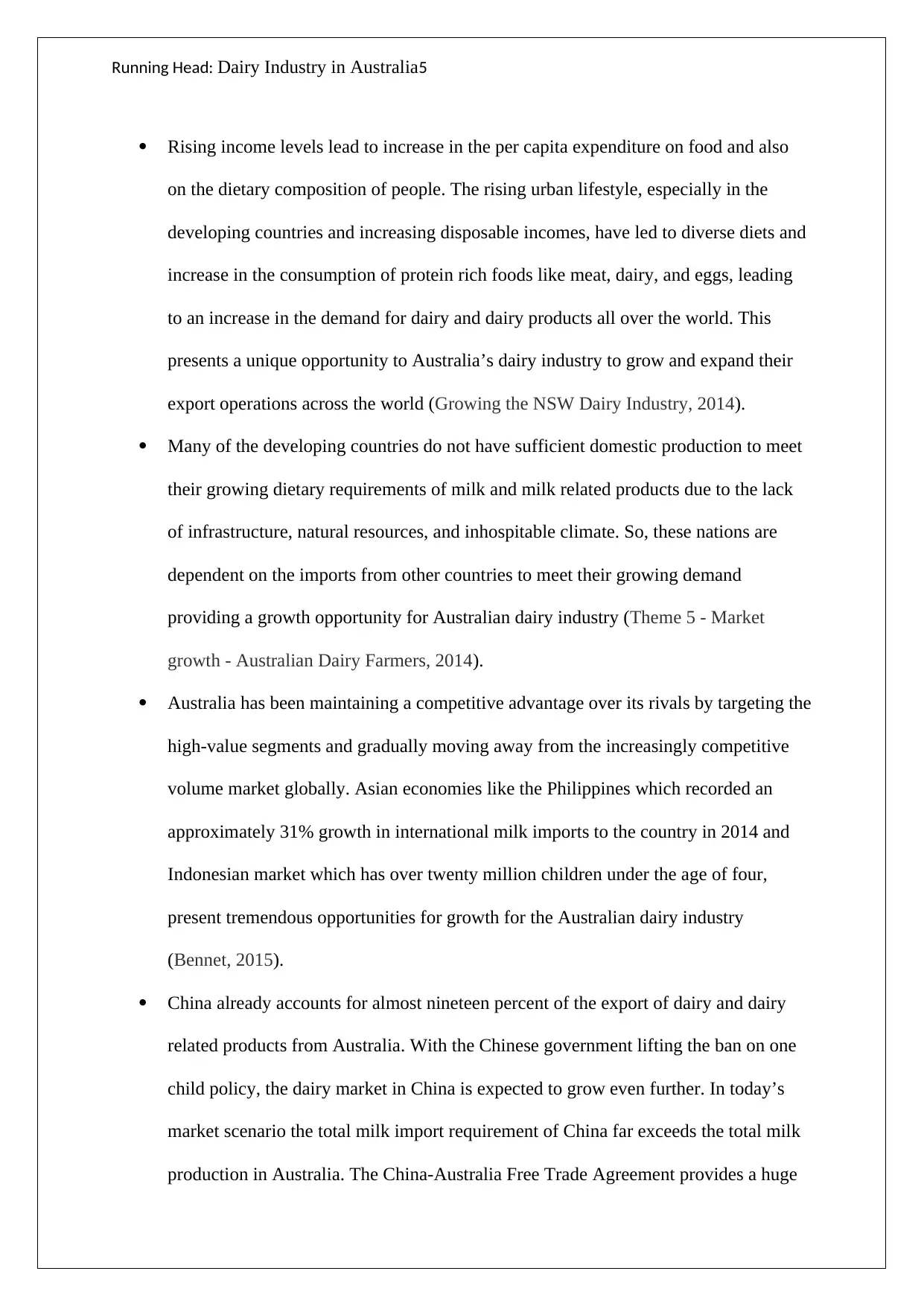
Running Head: Dairy Industry in Australia5
Rising income levels lead to increase in the per capita expenditure on food and also
on the dietary composition of people. The rising urban lifestyle, especially in the
developing countries and increasing disposable incomes, have led to diverse diets and
increase in the consumption of protein rich foods like meat, dairy, and eggs, leading
to an increase in the demand for dairy and dairy products all over the world. This
presents a unique opportunity to Australia’s dairy industry to grow and expand their
export operations across the world (Growing the NSW Dairy Industry, 2014).
Many of the developing countries do not have sufficient domestic production to meet
their growing dietary requirements of milk and milk related products due to the lack
of infrastructure, natural resources, and inhospitable climate. So, these nations are
dependent on the imports from other countries to meet their growing demand
providing a growth opportunity for Australian dairy industry (Theme 5 - Market
growth - Australian Dairy Farmers, 2014).
Australia has been maintaining a competitive advantage over its rivals by targeting the
high-value segments and gradually moving away from the increasingly competitive
volume market globally. Asian economies like the Philippines which recorded an
approximately 31% growth in international milk imports to the country in 2014 and
Indonesian market which has over twenty million children under the age of four,
present tremendous opportunities for growth for the Australian dairy industry
(Bennet, 2015).
China already accounts for almost nineteen percent of the export of dairy and dairy
related products from Australia. With the Chinese government lifting the ban on one
child policy, the dairy market in China is expected to grow even further. In today’s
market scenario the total milk import requirement of China far exceeds the total milk
production in Australia. The China-Australia Free Trade Agreement provides a huge
Rising income levels lead to increase in the per capita expenditure on food and also
on the dietary composition of people. The rising urban lifestyle, especially in the
developing countries and increasing disposable incomes, have led to diverse diets and
increase in the consumption of protein rich foods like meat, dairy, and eggs, leading
to an increase in the demand for dairy and dairy products all over the world. This
presents a unique opportunity to Australia’s dairy industry to grow and expand their
export operations across the world (Growing the NSW Dairy Industry, 2014).
Many of the developing countries do not have sufficient domestic production to meet
their growing dietary requirements of milk and milk related products due to the lack
of infrastructure, natural resources, and inhospitable climate. So, these nations are
dependent on the imports from other countries to meet their growing demand
providing a growth opportunity for Australian dairy industry (Theme 5 - Market
growth - Australian Dairy Farmers, 2014).
Australia has been maintaining a competitive advantage over its rivals by targeting the
high-value segments and gradually moving away from the increasingly competitive
volume market globally. Asian economies like the Philippines which recorded an
approximately 31% growth in international milk imports to the country in 2014 and
Indonesian market which has over twenty million children under the age of four,
present tremendous opportunities for growth for the Australian dairy industry
(Bennet, 2015).
China already accounts for almost nineteen percent of the export of dairy and dairy
related products from Australia. With the Chinese government lifting the ban on one
child policy, the dairy market in China is expected to grow even further. In today’s
market scenario the total milk import requirement of China far exceeds the total milk
production in Australia. The China-Australia Free Trade Agreement provides a huge
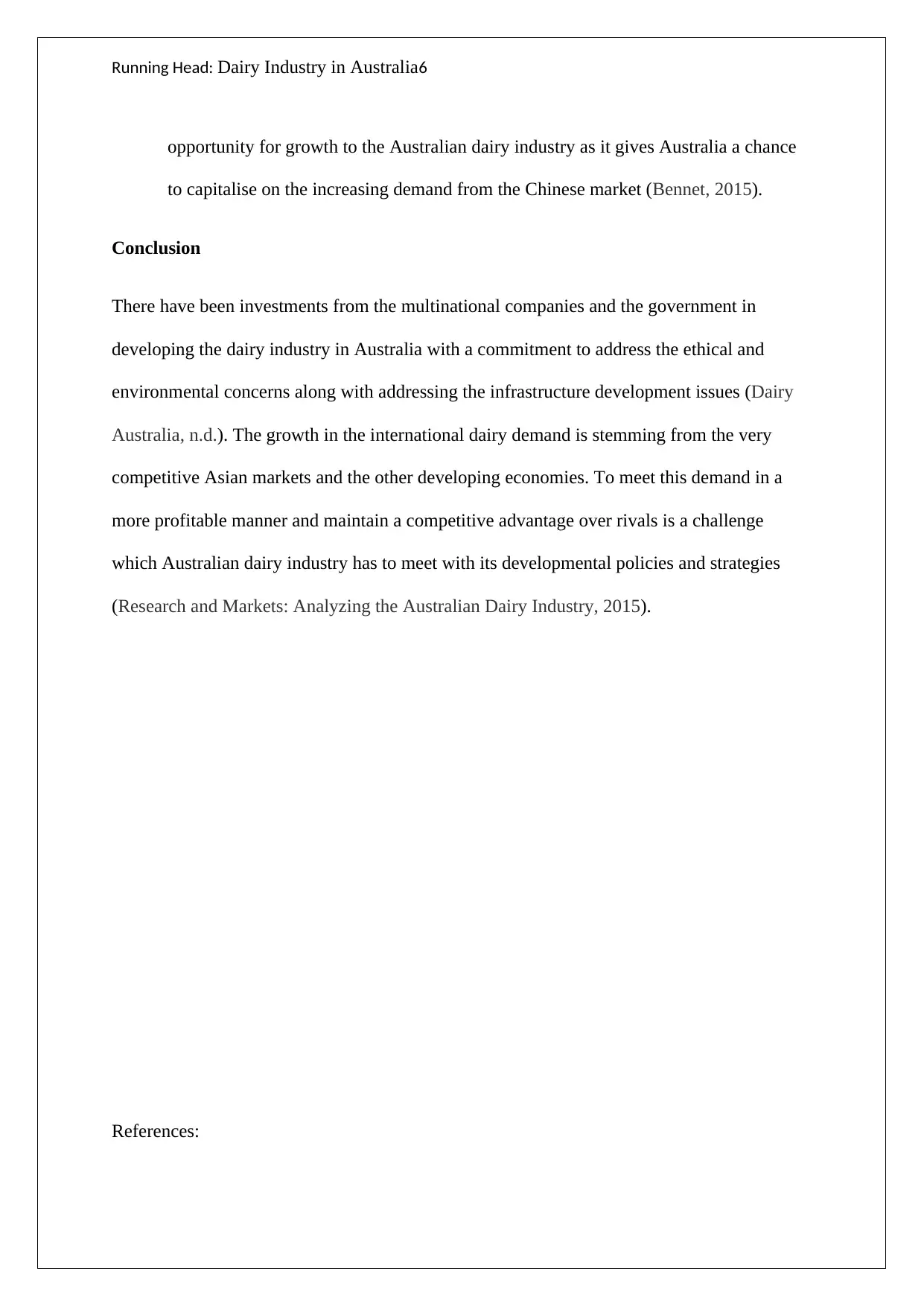
Running Head: Dairy Industry in Australia6
opportunity for growth to the Australian dairy industry as it gives Australia a chance
to capitalise on the increasing demand from the Chinese market (Bennet, 2015).
Conclusion
There have been investments from the multinational companies and the government in
developing the dairy industry in Australia with a commitment to address the ethical and
environmental concerns along with addressing the infrastructure development issues (Dairy
Australia, n.d.). The growth in the international dairy demand is stemming from the very
competitive Asian markets and the other developing economies. To meet this demand in a
more profitable manner and maintain a competitive advantage over rivals is a challenge
which Australian dairy industry has to meet with its developmental policies and strategies
(Research and Markets: Analyzing the Australian Dairy Industry, 2015).
References:
opportunity for growth to the Australian dairy industry as it gives Australia a chance
to capitalise on the increasing demand from the Chinese market (Bennet, 2015).
Conclusion
There have been investments from the multinational companies and the government in
developing the dairy industry in Australia with a commitment to address the ethical and
environmental concerns along with addressing the infrastructure development issues (Dairy
Australia, n.d.). The growth in the international dairy demand is stemming from the very
competitive Asian markets and the other developing economies. To meet this demand in a
more profitable manner and maintain a competitive advantage over rivals is a challenge
which Australian dairy industry has to meet with its developmental policies and strategies
(Research and Markets: Analyzing the Australian Dairy Industry, 2015).
References:
⊘ This is a preview!⊘
Do you want full access?
Subscribe today to unlock all pages.

Trusted by 1+ million students worldwide
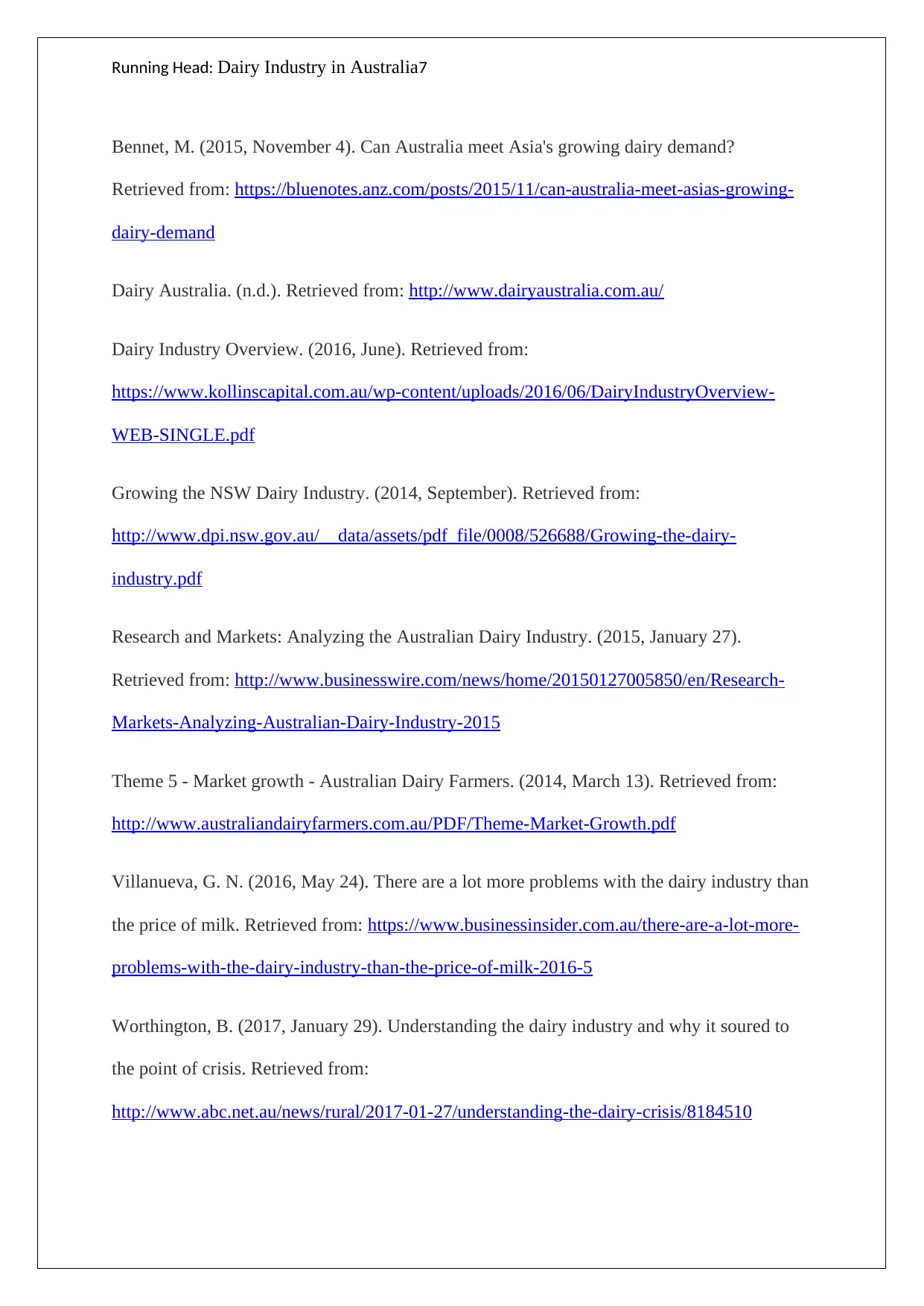
Running Head: Dairy Industry in Australia7
Bennet, M. (2015, November 4). Can Australia meet Asia's growing dairy demand?
Retrieved from: https://bluenotes.anz.com/posts/2015/11/can-australia-meet-asias-growing-
dairy-demand
Dairy Australia. (n.d.). Retrieved from: http://www.dairyaustralia.com.au/
Dairy Industry Overview. (2016, June). Retrieved from:
https://www.kollinscapital.com.au/wp-content/uploads/2016/06/DairyIndustryOverview-
WEB-SINGLE.pdf
Growing the NSW Dairy Industry. (2014, September). Retrieved from:
http://www.dpi.nsw.gov.au/__data/assets/pdf_file/0008/526688/Growing-the-dairy-
industry.pdf
Research and Markets: Analyzing the Australian Dairy Industry. (2015, January 27).
Retrieved from: http://www.businesswire.com/news/home/20150127005850/en/Research-
Markets-Analyzing-Australian-Dairy-Industry-2015
Theme 5 - Market growth - Australian Dairy Farmers. (2014, March 13). Retrieved from:
http://www.australiandairyfarmers.com.au/PDF/Theme-Market-Growth.pdf
Villanueva, G. N. (2016, May 24). There are a lot more problems with the dairy industry than
the price of milk. Retrieved from: https://www.businessinsider.com.au/there-are-a-lot-more-
problems-with-the-dairy-industry-than-the-price-of-milk-2016-5
Worthington, B. (2017, January 29). Understanding the dairy industry and why it soured to
the point of crisis. Retrieved from:
http://www.abc.net.au/news/rural/2017-01-27/understanding-the-dairy-crisis/8184510
Bennet, M. (2015, November 4). Can Australia meet Asia's growing dairy demand?
Retrieved from: https://bluenotes.anz.com/posts/2015/11/can-australia-meet-asias-growing-
dairy-demand
Dairy Australia. (n.d.). Retrieved from: http://www.dairyaustralia.com.au/
Dairy Industry Overview. (2016, June). Retrieved from:
https://www.kollinscapital.com.au/wp-content/uploads/2016/06/DairyIndustryOverview-
WEB-SINGLE.pdf
Growing the NSW Dairy Industry. (2014, September). Retrieved from:
http://www.dpi.nsw.gov.au/__data/assets/pdf_file/0008/526688/Growing-the-dairy-
industry.pdf
Research and Markets: Analyzing the Australian Dairy Industry. (2015, January 27).
Retrieved from: http://www.businesswire.com/news/home/20150127005850/en/Research-
Markets-Analyzing-Australian-Dairy-Industry-2015
Theme 5 - Market growth - Australian Dairy Farmers. (2014, March 13). Retrieved from:
http://www.australiandairyfarmers.com.au/PDF/Theme-Market-Growth.pdf
Villanueva, G. N. (2016, May 24). There are a lot more problems with the dairy industry than
the price of milk. Retrieved from: https://www.businessinsider.com.au/there-are-a-lot-more-
problems-with-the-dairy-industry-than-the-price-of-milk-2016-5
Worthington, B. (2017, January 29). Understanding the dairy industry and why it soured to
the point of crisis. Retrieved from:
http://www.abc.net.au/news/rural/2017-01-27/understanding-the-dairy-crisis/8184510
Paraphrase This Document
Need a fresh take? Get an instant paraphrase of this document with our AI Paraphraser
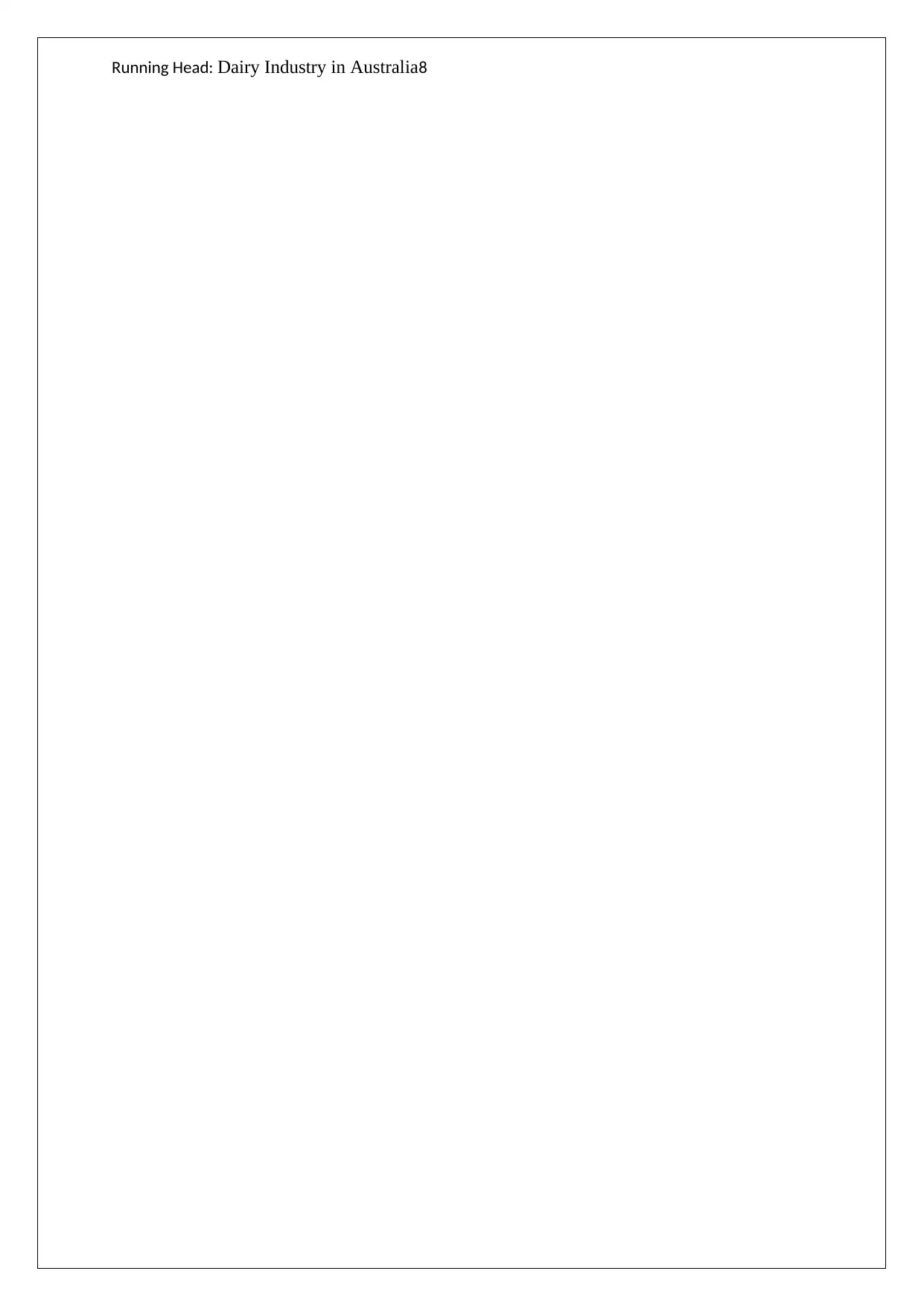
Running Head: Dairy Industry in Australia8
1 out of 8
Related Documents
Your All-in-One AI-Powered Toolkit for Academic Success.
+13062052269
info@desklib.com
Available 24*7 on WhatsApp / Email
![[object Object]](/_next/static/media/star-bottom.7253800d.svg)
Unlock your academic potential
Copyright © 2020–2025 A2Z Services. All Rights Reserved. Developed and managed by ZUCOL.




